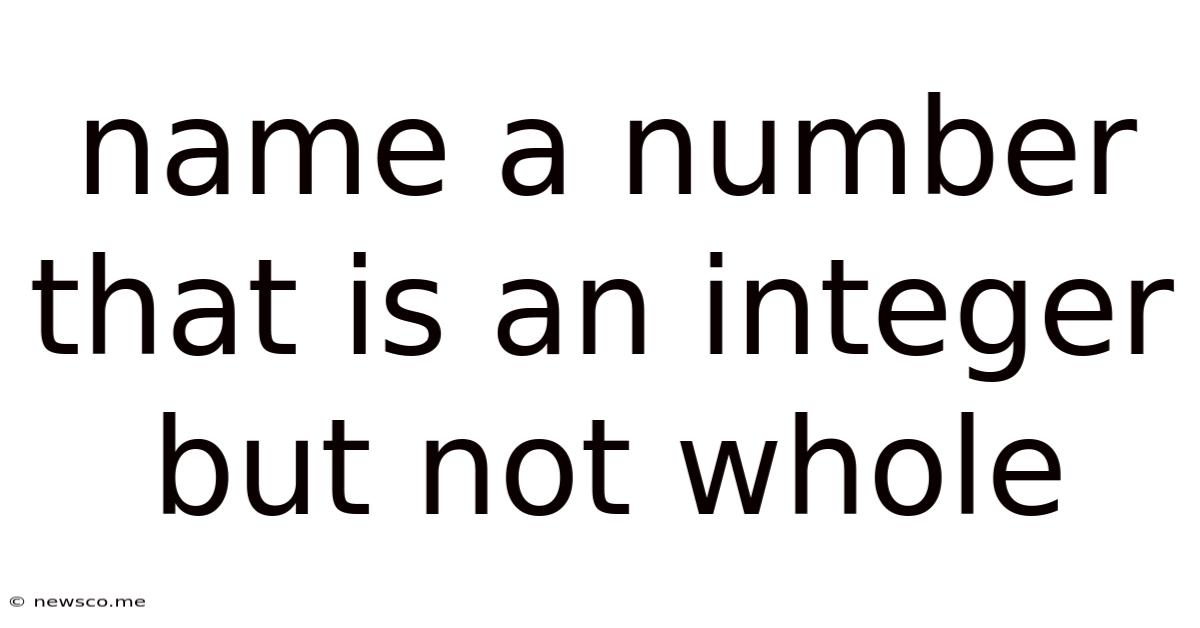Name A Number That Is An Integer But Not Whole
News Co
Apr 18, 2025 · 4 min read

Table of Contents
Naming a Number That's an Integer but Not Whole: Exploring the Nuances of Number Systems
The seemingly simple question, "Name a number that is an integer but not a whole number," delves into the fascinating intricacies of number systems. While the terms might seem interchangeable at first glance, understanding their subtle differences is crucial for anyone working with mathematics, computer science, or any field that utilizes numerical data. This article will dissect the definitions of integers and whole numbers, highlighting their distinctions and providing examples to solidify understanding. We'll explore the broader context of number systems, examining their evolution and practical applications. Finally, we'll address common misconceptions and provide resources for further exploration.
Understanding Integers and Whole Numbers
Before we can identify a number that fits our criteria, let's precisely define "integer" and "whole number." These terms often appear together, leading to confusion, but they represent distinct sets within the broader realm of numbers.
What is an Integer?
An integer is any number that can be written without a fractional or decimal component. This includes positive numbers (1, 2, 3, ...), negative numbers (-1, -2, -3, ...), and zero (0). In essence, integers represent whole units without any parts. They form the foundation for many mathematical operations and concepts. The set of integers is often denoted by the symbol ℤ.
What is a Whole Number?
A whole number is a non-negative integer. This means it's a member of the set {0, 1, 2, 3, ...}. Whole numbers are the counting numbers (1, 2, 3, ...) along with zero. They are used extensively in everyday life for counting objects, measuring quantities, and representing discrete values.
The Key Distinction: Negativity
The crucial difference between integers and whole numbers lies in the inclusion of negative numbers. Integers encompass both positive and negative whole numbers, whereas whole numbers are strictly non-negative. This seemingly small distinction has significant consequences in mathematical operations and applications.
Answering the Question: A Number that is an Integer but Not a Whole Number
Now, armed with clear definitions, we can easily answer the initial question: Any negative integer is an integer but not a whole number.
For example:
- -1: This is an integer because it's a whole unit without a fractional part. However, it's not a whole number because whole numbers are non-negative.
- -100: Similarly, -100 is an integer but not a whole number.
- -5,000,000: Large negative numbers also follow this rule.
Therefore, the answer is straightforward: any negative integer.
Expanding Our Understanding: Number System Hierarchy
To fully grasp the concept, it's beneficial to visualize the hierarchy of number systems. Integers are a subset of a larger set called rational numbers, which include fractions and decimals that can be expressed as a ratio of two integers (e.g., 1/2, 0.75). Rational numbers, in turn, are a subset of real numbers, which encompass all numbers on the number line, including irrational numbers (like π and √2) which cannot be expressed as a ratio of two integers. Finally, real numbers are a subset of complex numbers, which include imaginary numbers (numbers involving the square root of -1).
Visual Representation:
Complex Numbers ⊃ Real Numbers ⊃ Rational Numbers ⊃ Integers ⊃ Whole Numbers
Practical Applications and Common Misconceptions
Understanding the distinction between integers and whole numbers is crucial in various contexts:
- Computer Science: Many programming languages have distinct data types for integers and unsigned integers (similar to whole numbers). Choosing the correct data type is essential for efficient memory management and avoiding errors.
- Finance: Tracking profit and loss often involves negative integers, representing debts or deficits.
- Physics: Representing physical quantities like temperature (which can be below zero) requires the use of integers that aren't whole numbers.
Common Misconceptions:
- Assuming all integers are whole numbers: This is a frequent mistake. Remember that integers include negative numbers, which are not considered whole numbers.
- Confusing integers with rational numbers: While integers are rational numbers (they can be expressed as a ratio of themselves and 1), not all rational numbers are integers. Fractions and decimals are rational but not integers.
Beyond the Basics: Exploring Further
The world of numbers extends far beyond integers and whole numbers. Exploring more complex number systems, like complex numbers and quaternions, reveals deeper mathematical structures and applications in advanced fields like quantum mechanics and computer graphics. Delving into the history of mathematics reveals the evolution of these concepts, and how different civilizations approached the challenges of representing and manipulating numbers.
Conclusion: A Foundation for Mathematical Understanding
The seemingly simple distinction between integers and whole numbers serves as a crucial foundation for a deeper understanding of mathematics. By clarifying these definitions and exploring the broader context of number systems, we can appreciate the richness and complexity of numerical representation. Understanding the subtle differences between these seemingly similar terms is crucial for accuracy and precision in various disciplines, paving the way for more advanced mathematical explorations. The ability to confidently identify a number that is an integer but not whole demonstrates a foundational understanding of number theory and its practical implications. This fundamental knowledge is essential for anyone seeking to further their studies in mathematics or related fields.
Latest Posts
Related Post
Thank you for visiting our website which covers about Name A Number That Is An Integer But Not Whole . We hope the information provided has been useful to you. Feel free to contact us if you have any questions or need further assistance. See you next time and don't miss to bookmark.